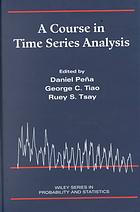

Most ebook files are in PDF format, so you can easily read them using various software such as Foxit Reader or directly on the Google Chrome browser.
Some ebook files are released by publishers in other formats such as .awz, .mobi, .epub, .fb2, etc. You may need to install specific software to read these formats on mobile/PC, such as Calibre.
Please read the tutorial at this link: https://ebookbell.com/faq
We offer FREE conversion to the popular formats you request; however, this may take some time. Therefore, right after payment, please email us, and we will try to provide the service as quickly as possible.
For some exceptional file formats or broken links (if any), please refrain from opening any disputes. Instead, email us first, and we will try to assist within a maximum of 6 hours.
EbookBell Team

4.0
96 reviewsThis book is based on the lectures of the ECAS' 97 Course in Time Series Analysis
held at El Escorial, Madrid, Spain, from September 15 to September 19, 1997. The
course was sponsored by the European Courses in Advanced Statistics (ECAS). In
accordance with the objectives of ECAS, the lectures are directed to both researchers
and teachers of statistics in academic institutions and statistical professionals in industry
and govermment, with the goal of presenting an overview of the current status
of the area. In particular, different approaches to time series analysis are discussed and
compared. In editing the book, we have worked hard to uphold ECAS' objectives. In
addition, special efforts have been made to unify the notation and to include as many
topics as possible, so that readers of the book can have an overview of the current
status of time series research and applications.
The book consists of three main components. The first component concern basic
materials of univariate time series analysis presented in the first eight chapters. It
includes recent developments in outlier detection, automatic model selection, and
seasonal adjustment. The second component addresses advanced topics in univariate
time series analysis such as conditional heteroscedastic models, nonlinear models,
Bayesian analysis, nonparametric methods, and neural networks. This component
represents current research activities in univariate time series analysis. The third and
final component of the book concerns with multivariate time series, including vector
ARMA models, cointegration, and linear systems.
The book can be used as a principal text or a complementary text for courses
in time series. A basic time series course can be taught from the first part of the
book that presents the basic material that can be found in the standard texts in time
series. This part also includes topics not normally covered in these texts, such as
the extended and inverse autocorrelation function, the decomposition of the forecast
function of ARIMA models, a detailed analysis of outliers and influential observations
and automatic methods for model building and model based seasonal adjustment. For
a basic course this book should be complemented with some of the excellent texts
available. The book would be very well suited for an advanced course in which
some of the basic material can be quickly reviewed using the first part, that skips
many details and concentrates in the main concepts of general applicability. Then the course can concentrate in the topics in Parts 2 and 3. If the scope of the course is more
in methodological extensions of univariate linear models the material in Part 2 can
be useful, whereas if the objective is to introduce multivariate modeling Part 3 will
be appropriate. To facilitate the use of the book as a text, all the time series data used
in this book can be down loaded from the web address: http://gsbwww.
uchicago. edu/fac/ruey. tsay/teaching/ecas/